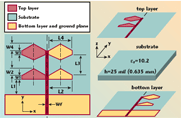
Microstrip antennas have recently gained wide popularity, because they exhibit a low profile, small size, lightweight, low manufacturing cost, high efficiency, and an easy method of fabrication and installation. Furthermore, they are generally economical to produce since they are readily adaptable to hybrid and monolithic integrated circuit fabrication techniques at RF and microwave frequencies.1 Phased arrays and spatial power combiners2,3 are among the present areas that extensively explore the use of microstrip antennas. In these applications, there is a particular interest to obtain a larger operational bandwidth of the array, which implicitly means the need for wideband antenna elements.
In order for an antenna element to be considered for wideband phased arrays and power combiners, it has to have stable radiation characteristics over the entire operating band. The antenna should provide end-fire radiation with a high front-to-back ratio, polarization purity and a wide 3 dB beam width to allow for wide scanning capabilities. A low coupling between array elements is also required in phased-array systems in order to avoid scan blindness and anomalies within the desired bandwidth and scan volume. Among the most widely used printed antennas in phased-array systems are quasi-Yagi, dipole, printed Lotus and bow-tie antennas.
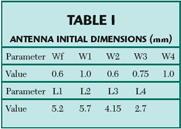
The microstrip-fed quasi-Yagi antenna consists of a half-wavelength dipole and an approximately quarter wavelength rectangular director to increase the gain and improve the front-to-back ratio. A wide operational bandwidth of 48 percent was demonstrated at X-band.4,5 By replacing the dipole and the director of the quasi-Yagi antenna with a bow-tie, the bandwidth was improved to 60 percent, and the antenna size was reduced by 20 percent.6 Further research resulted in a novel microstrip-fed printed antenna, called a printed Lotus antenna, with a modified balun.7 The printed Lotus provides 60 percent bandwidth with a fairly low return loss. However, the balun is based on a half-wavelength delay line, designed at the center frequency. This narrow band delay line limits the bandwidth of the antenna. In addition, the radiation patterns are deteriorated at the higher frequencies, which decrease the antenna usable bandwidth.
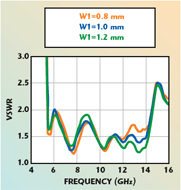
An alternative method of feeding such antennas has been reported.8–14 One half of the antenna dipole or bow-tie is printed on the top substrate layer and connected to the microstrip feed line, while the second half is printed on the bottom substrate layer and connected to the ground plane. This avoids using the half-wavelength balun and simplifies the antenna geometry. In addition, one can also obtain end-fire radiation patterns with good front-to-back ratio.12–14 Wide impedance bandwidths of 68 percent13 and 91 percent14 have been obtained by this method. The wide bandwidth is mainly obtained by modifying the antenna shape and its matching circuit, and by increasing the substrate height. However, using an antenna with one resonator results in a distorted pattern at high frequencies, where the antenna size is much bigger than a half wavelength. Additionally, if the substrate height is large relative to the free space wavelength at the upper operating frequency, the radiation patterns at the higher frequencies will be distorted. The deterioration of the radiation patterns results in a small usable bandwidth of 60 percent compared to an impedance bandwidth of 91 percent.

In order to solve this problem, antennas with thin substrate and multiple resonators are proposed. This article presents a new broadband antenna design with an enhanced pattern stability and usable bandwidth. This design offers advantages over existing antennas used in phased arrays and power combiners. The antenna exhibits low cross polarization, high gain and wide 3 dB beam width over the entire operating band. A numerical analysis for its parameters is presented for the physical understanding of the antenna operation. The VSWR and far-field radiation characteristics of the antenna final design are presented. Results for a modified two-element array configuration are also presented. The simulations and analyses for the antennas are performed using a commercial computer software package, Ansoft HFSS, which is based on the finite element method. Verifications for the computed VSWR, coupling and far-field radiation patterns are performed using measurements on a prototype antenna.
Antenna Geometry and Operation

The schematic and parameters of the proposed antenna are illustrated in detail in Figure 1. The antenna consists of two modified dipoles with different lengths. The short dipole has a rhombus shape, while the long one consists of a rectangular dipole and triangle. The left halves of the two dipoles are on the top of the substrate, while the right halves are on the bottom. The upper and lower halves are then connected to a microstrip feed line with a truncated ground plane through two printed microstrip lines on the top and bottom layers. The truncated ground plane acts as a reflector to produce the end-fire patterns. The proposed antenna is printed on a Rogers RT/Duroid 6010/6010 LM substrate with a dielectric constant of 10.2, a dielectric loss (tanδ) of 0.0023 and a thickness of 25 mil (0.635 mm).
The operation of this antenna depends mainly on its high dielectric constant substrate material and its shape. Due to the high dielectric constant substrate material, most of the electromagnetic field is concentrated in the dielectric between the conductive strip and the ground plane, and travels on the surface in the transverse directions (y and x), supported by the electric currents in the two halves of the dipoles, and the fringing fields at the far edges of the dipoles, respectively. However, the fringing field is much weaker. The truncated ground plane reflects the radiated fields in the y direction, which results in end-fire radiation. On the other hand, the antenna shape is playing the main role in the antenna operating bandwidth, because it acts as a matching circuit connected to the open circuited terminal of the microstrip feed line. The lengths of the long and short modified dipoles (L2 and L4) control the lower and upper operating frequencies, respectively. The distance between the two modified dipoles (L3) and the distance between the first modified dipole and the truncated ground plane (L1) control the VSWR level between the two main resonances.
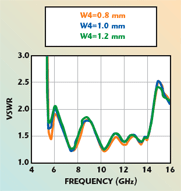
Antenna Analysis
To begin with, the dimensions of this antenna were selected so that the lengths of the long and short dipoles are λg/2 at 5 and 14 GHz, respectively, to cover the same frequency band as the antenna reported previously.14 The dimensions were then optimized based on the numerical results until initial values were obtained for the design to cover the required frequency range. The initial dimensions are shown in Table 1. Next, a parametric study was performed to understand the effect of each antenna and to further improve on the antenna results. One parameter is changed at a time, while all other parameters are kept as given in the table. Figures 2 to 9 show the effect of the antenna parameters on the computed VSWR using Ansoft HFSS.
The VSWR level at 6 GHz and between 11 and 14.5 GHz improves by increasing W1, while it increases between 7.3 and 9.2 GHz. Increasing W2 decreases the VSWR level around 9 GHz and increases it at 6 GHz and between 11 and 13 GHz. Increasing W3 decreases the VSWR level between 5.5 and 6.5 GHz. Increasing W4 decreases the VSWR level between 5.5 and 6.5 GHz and between 10.5 and 14 GHz. Generally, all the “W” parameters do not have a noticeable effect on the bandwidth.

L1 has an obvious effect at higher frequencies between 8 and 16 GHz. As L1 increases, the bandwidth decreases and the VSWR level decreases at 6 GHz, between 8 and 10.5 GHz, and around 13 GHz, and increases around 11 GHz and between 13.5 and 16 GHz. In contrast, the effect of L2 is more at lower frequencies before 11 GHz. As L2 increases, the VSWR level improves before 8 GHz causing the lower operating frequency to shift to lower frequencies because the length of the long dipole increases. Increasing L3 improves the VSWR between 11 and 14 GHz, and increases it at 6 GHz and around 8.7 GHz, which is opposite to the effect of L1. Finally, as L4 increases, the VSWR level increases around between 5.5 and 8.5 GHz, and between 14 and 16 GHz, while it decreases between 8.5 and 14 GHz.
From this parametric study, it is clear that the “L” parameters have more effect on the antenna performance. L2 and L4 are generally controlling the lower and upper operating frequencies. L1 and L3 together with L2 and L4 compose two tap monopoles on both top and bottom substrate layers, which add new resonances to the antenna. Since L1 affects the length of both monopoles, it has more effect than L3. In addition, L1 and L3 control the couplings between the ground plane and the long dipole, and between the long and short dipoles. The “W” parameters have some effect on these couplings, too. In addition, W3 and W4 play an important role in matching the dipoles to the feed line by introducing a tapered transition rather than a sharp one.

Measured and Computed Results for One Element
A prototype of this antenna was built with the dimensions shown in Table 1. The VSWR was computed using Ansoft HFSS and measured using a HP 8510 vector network analyzer. The measured and simulated VSWR of this antenna are shown in Figure 10 and show good agreement. The small discrepancies between the computed and measured results may occur because of the effect of the SMA connector and fabrication imperfections. The antenna operates from 5.4 to 14.8 GHz with a wide impedance bandwidth of 93 percent. For this operating frequency band, the size of the antenna is approximately 0.22 and 0.59 free space wavelengths at the lower and upper operating frequencies, respectively. This length allows this antenna to fit into phased arrays with only minor grating lobes at higher frequencies. The measured and simulated radiation patterns at 10 GHz in the H- and E-planes are shown in Figure 11. A good agreement is noticed, which further verifies the simulation results using Ansoft HFSS.
The radiation patterns are then computed at selective frequencies that cover the entire operating band and are shown in Figures 12 and 13 in the H- and E-planes, respectively. The radiation patterns at the lower operating frequencies are more stable; therefore, they are presented at 6, 8 and 10 GHz only. In the higher operating frequency range, the radiation patterns are less stable and for that reason are presented at 11, 12, 13, 13.5 and 14 GHz. In the H-plane (y-z), the antenna provides end-fire radiation patterns up to 14 GHz, with high front-to-back ratios between 9 and 25 dB. The maximum cross-polarization level is around –11 dB considering only the 3 dB beamwidth range. The first dotted circle in the polar plots represents the –3 dB level. The 3 dB beamwidth is generally wide and spans from 110° to 180°. In the E-plane (x-y), the antenna is also providing end-fire radiation patterns up to 14 GHz, but they are distorted at 14 GHz. The 3 dB beamwidth spans from 75° to 130° between 6 and 13.5 GHz, and 20° at 14 GHz.

These results show that the usable bandwidth of this antenna is approximately 86 percent. Consequently, it provides a significant improvement over all previously published antennas in terms of usable bandwidth. Compared with the one described previously by the author,14 this antenna shows a 26 percent improvement in usable bandwidth.
Results of Modified Two-element Arrays
A modified two-element array configuration is used to test the antenna performance in an array environment. The proposed two-element array configuration and its prototype are shown in Figure 14. The second element is mirrored along the y-axis, and consequently a 180° phase shift is introduced at Port 2 to have the same current direction in both elements. The current direction is roughly illustrated in the figure. This modification is required, especially at high frequencies where the effect of the substrate height is significant, in order to provide balanced patterns. This modification also reduces the cross-polarization level, because the electric fields between the upper and lower layers in the z-direction and the electric currents in the y-direction in one antenna are opposite to those of the other antenna. A slit is introduced in the ground plane to decrease the coupling by disturbing the path of the transverse surface waves traveling in the substrate. The distance between elements should be as small as possible to reduce the grating lobes at high frequencies; therefore, it is chosen to be 14 mm.
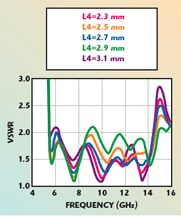
Figures 15 and 16 show the radiation patterns in the H- and E-planes, respectively, for the two-element array at 6, 8, 10, 12, 13, 13.5, 14 and 14.5 GHz. If the H-plane radiation patterns of the two-element array are compared to those of a single element, it is noticed that in the two-element antenna array the cross-polarization level is reduced significantly and is completely eliminated in the direction of maximum gain, due to the array symmetry. In the E-plane, the cross-polarization level is also reduced, and the radiation patterns are stable up to 14.5 GHz. Therefore, by using this configuration, the usable bandwidth is equal to the impedance bandwidth, that is 93 percent. The gains for a one-element and two-element array are depicted in Figure 17. The average gain for one element is approximately 6 dB, while for the two-element array the average is approximately 8.4 dB. Finally, the measured and computed couplings are shown in Figure 18. A good agreement is noticed, which further verifies the simulation results. The average coupling between elements is approximately –20 dB, with a minimum value of –25 dB and a maximum value of –11 dB.
Conclusion

A new antenna is presented that achieves a wide usable bandwidth of 86 percent. The pattern stability is obtained by using two resonators built on both sides of a thin substrate. A modified array configuration is used to enhance the radiation characteristics and stability, and results in a 93 percent usable bandwidth. This antenna is a very good candidate for wideband wireless communications, phased-array antenna systems and power combiners.
Acknowledgment
The author would like to thank Guiping Zheng from the department of electrical engineering, University of Mississippi, for building and measuring the antennas presented in this article.
References
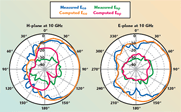
1. L.G. Maloratsky, “Reviewing the Basics of Microstrip Lines,” Microwave & RF, March 2000, pp. 79–88.
2. R.J. Mailloux, Phased Array Handbook, Artech House Inc., Norwood, MA, 1994.
3. J.A. Navarro and K. Chang, Eds., Integrated Active Antennas and Spatial Power Combining, John Wiley & Sons Inc., New York, NY, 1996.
4. W. Deal, N. Kaneda, J. Sor, Y. Qian and T. Itoh, “A New Quasi-yagi Antenna for Planar Active Antenna Arrays,” IEEE Transactions on Microwave Theory and Techniques, Vol. 48, No. 6, June 2000, pp. 910–918.

5. N. Kaneda, W. Deal, Y. Qian, R. Waterhouse and T. Itoh, “A Broadband Planar Quasi-yagi Antenna,” IEEE Transactions on Antennas and Propagation, Vol. 50, No. 8, August 2002, pp. 1158–1160.
6. A.A. Eldek, A.Z. Elsherbeni and C.E. Smith, “Characteristics of a Microstrip-fed Printed Bow-tie Antenna,” Microwave and Optical Technology Letters, Vol. 43, No. 2, October 2004, pp. 123–126.
7. A.Z. Elsherbeni, A.A. Eldek and C.E. Smith, “Wideband Slot and Printed Antennas,” book chapter in Encyclopedia of RF and Microwave Engineering, K. Change, Ed., John Wiley & Sons Inc., New York, NY, March 2005.

8. S. Dey, C.K. Aanandan, P. Mohanan and K.G. Nair, “Analysis of Cavity Backed Printed Dipoles,” Electronics Letters, Vol. 30, No. 30, 1994, pp. 173–174.
9. G.A. Evtioushkine, J.W. Kim and K.S. Han, “Very Wideband Printed Dipole Antenna Array,” Electronics Letters, Vol. 34, No. 24, 1998, pp. 2292–2293.
10. Y.D Lin and S.N Tsai, “Analysis and Design of Broadband Coupled Stripline-fed Bow-tie Antennas,” IEEE Transactions on Antennas and Propagation, Vol. 46, No. 3, March 1998, pp. 459–560.
11. G.Y Chen and J.S Sun, “A Printed Dipole Antenna with Microstrip Tapered Balun,” Microwave and Optical Technology Letters, Vol. 40, No. 4, February 2004, pp. 344–346.

12. F. Tefiku and C.A. Grimes, “Design of Broadband and Dual-band Antennas Comprised of Series-fed Printed-strip Dipole Pairs,” IEEE Transactions on Antennas and Propagation, Vol. 48, No. 6, June 2000, pp. 895–900.
13. G. Zheng, A.A. Kishk, A.W. Glisson and A.B. Yakovlev, “A Broadband Printed Bow-tie Antenna with a Simplified Balanced Feed,” Microwave and Optical Technology Letters, Vol. 47, No. 6, December 2005, pp. 534–536.
14. A.A. Eldek, A.Z. Elsherbeni and C.E. Smith, “Wideband Modified Printed Bow-tie Antenna with Single and Dual Polarization for C- and X-band Applications,” IEEE Transaction on Antennas and Propagation, Vol. 53, No. 9, September 2005, pp. 3067–3072.
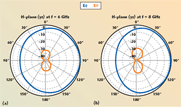
Abdelnasser A. Eldek received his BSc degree (with honors) in electronics and communications engineering from Zagazig University, Egypt, in 1993, his MS degree in electrical engineering from the Eindhoven University of Technology, The Netherlands, in 1999, and his PhD degree in electrical engineering from the University of Mississippi in 2004. He was a research assistant in the department of microwaves at the Electronic Research Institute, Cairo, Egypt, from 1995 to 1996. From January 2001 to December 2004, he was a research and teacher assistant in the department of electrical engineering at the University of Mississippi. He is currently an assistant professor in the department of computer engineering, Jackson State University, Jackson, MS. His current research interests include electromagnetic theory, antennas, phased arrays and numerical methods.

Abdelnasser A. Eldek
